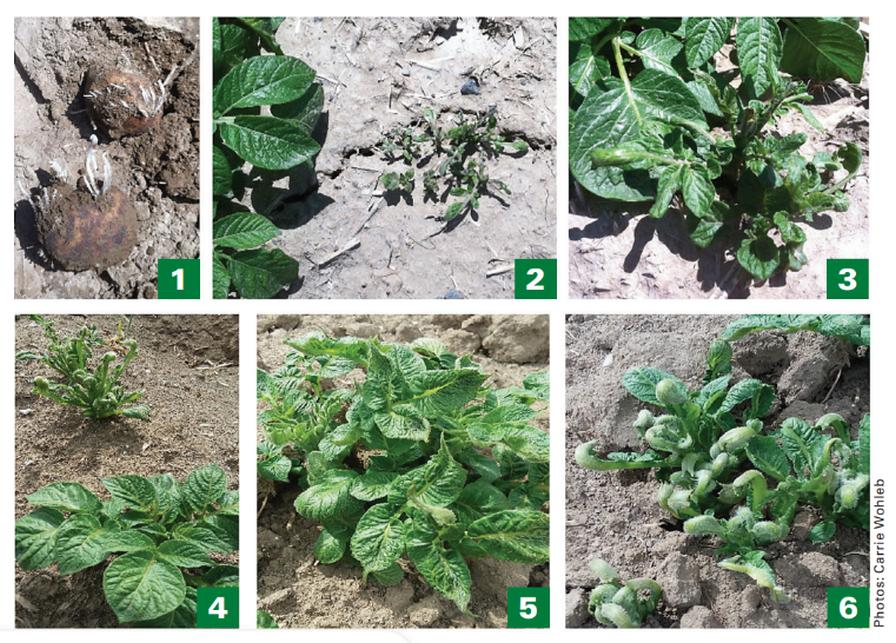How To Recognize When Herbicides Are Impacting Your Potato Seed Tubers
Herbicides like glyphosate (e.g., Roundup) and clopyralid (e.g., Stinger) can accumulate in daughter tubers if they drift onto or are accidentally applied to potato foliage. This can result in problems the following season when the tubers are used as seed. Herbicide carryover in potato seed can inhibit sprouting, delay emergence, and cause various sprout, stem, and leaf distortions.
Symptomatic plants are usually scattered throughout the field because symptom expression varies with the concentration of herbicide residues in individual seed tubers.

Glyphosate carryover in seed can delay normal sprouting, or it can prevent sprouting. It can also cause multiple sprouts to form from a single eye, known as “candelabra sprouting” (Fig. 1). Many stunted shoots may emerge (Fig. 2). Foliar injury symptoms can include yellowing, and downward bent (epinasty) and twisted leaves (Fig. 3). Plants grow out of these symptoms as glyphosate residues are metabolized, so the next generation of tubers won’t carryover the herbicide, but U.S. No. 1 and total yields may be reduced because of delayed growth and poor stands.
Clopyralid carryover in seed can delay emergence so affected plants are smaller than healthy plants (Fig 4). Foliar injury usually involves leaf distortion. Lower residues of clopyralid can cause crinkled leaves with some parallel venation (Fig. 5), while higher doses cause fiddle-necking, giving the leaves a hooded appearance (Fig. 6). The residues are eventually metabolized, and later growth is normal. Clopyralid carryover in seed can result in smaller tubers, but total yields are not usually affected.
Herbicides That Don’t Carryover in Seed
Upwardly mobile (apoplastic) herbicides that move via the xylem (e.g., Atrazine) and non-translocating contact herbicides (e.g., Gramoxone) don’t move from foliage to tubers, so they don’t accumulate in potato seed. It’s important to note, however, these herbicides can injure potatoes in other ways. For example, atrazine applied to corn can carry over in the soil and damage potatoes planted in the same field the following year if its residues have not broken down sufficiently.
Herbicides That Carryover in Seed
The only herbicides capable of accumulating in tubers are downwardly mobile (symplastic) herbicides that move from foliage to growing points via the phloem. This includes a long list of products: auxin growth regulators (e.g., Banvel, Milestone, Stinger, Tordon), amino acid inhibitors (e.g., Pursuit, Raptor, Roundup), and sulfonylureas (e.g., Glean, Harmony). They can all carry over in seed tubers but don’t always cause significant plant injury or yield losses.
The potato growth stage at the time of herbicide exposure is another important factor. Seed potato crops exposed to translocating herbicides during the mid-bulking stage cause more problems for the subsequent crop, compared to exposures that occur at stolon hooking or tuber initiation. This makes sense because tubers compete with foliage during early developmental stages but are the main sink for translocated nutrients and carbohydrates during the mid-bulking stage.
What Can You Do?
Seed potato crops don’t always produce obvious symptoms after an herbicide exposure. And yet the following crop can be greatly impacted by the herbicide residues.
It’s important that seed potato growers scout their fields regularly for herbicide damage, keeping in mind that the symptoms can be slight. Tubers from plants that were exposed to translocating herbicides, regardless of damage done to the current crop, should not be used as seed the following year.
Notify neighbors and roadside weed maintenance crews when you are growing a crop that is sensitive to many herbicides. It may help to establish a “no spray zone” for seed potato crops near roads where weeds are managed with herbicides.
Diagnosing Herbicide Carryover in Seed
Potato growers should learn how to identify herbicide injury symptoms. Samples can be sent to chemical residue testing labs, but they can be very expensive, especially if you don’t know which herbicides to screen for.










